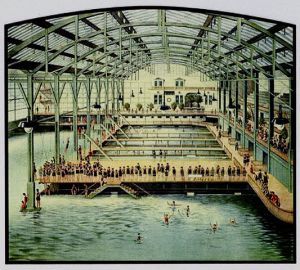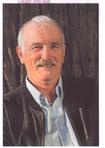John Michael McCarty's Blog, page 15
July 24, 2016
The Grateful Dead Connection to the North Bay
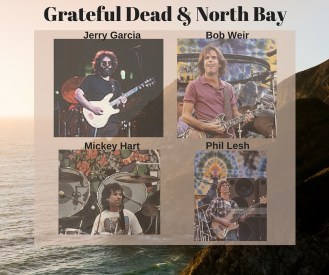 The Grateful Dead have long had a connection with the North Bay. The group was formed in 1965 in Palo Alto amid the rise of the counterculture movement. Jerry Garcia spent part of his early years in the tough outer Mission District of San Francisco before moving up to Sonoma County. He attended Analy High School in Sebastopol where he won his first battle of the bands. He helped write “Dark Star” in Rio Nido while performing there in September, 1967. The lyrics were symbolic of how “far out” the universe could get, and Captain Trips wanted to stick around as long as possible to see how weird it all might become. Unfortunately, however, he retreated to Marin where his demons caught up with him, dying of a heart attack in 1995.
The Grateful Dead have long had a connection with the North Bay. The group was formed in 1965 in Palo Alto amid the rise of the counterculture movement. Jerry Garcia spent part of his early years in the tough outer Mission District of San Francisco before moving up to Sonoma County. He attended Analy High School in Sebastopol where he won his first battle of the bands. He helped write “Dark Star” in Rio Nido while performing there in September, 1967. The lyrics were symbolic of how “far out” the universe could get, and Captain Trips wanted to stick around as long as possible to see how weird it all might become. Unfortunately, however, he retreated to Marin where his demons caught up with him, dying of a heart attack in 1995.
Grateful Dead in the North Bay:
The Grateful Dead have performed at several venues in the North Bay including The Barn (Rio Nido Dance Hall), River Theater in Guerneville, The Inn of the Beginning in Cotati, and the Veterans Memorial Building as well as the Sonoma County Fairgrounds in Santa Rose. Also, for a few months in 1967, the Grateful Dead lived and gave concerts at Olompoli in Novato, alongside Grace Slick and Janice Joplin.
Bob Weir, the youngest member of the original ensemble, played rhythm guitar and shared vocals with Jerry. Bob now lives in Mill Valley and tours with his band, RatDog. Phil Lesh was a classically trained trumpeter and played bass guitar for the Dead. He has settled in San Rafael where he manages Terrapin Crossroads, a restaurant and local music place. New Yorker Mickey Hart joined the band as a second drummer in ’67 and played several other percussion instruments as well. He has taken roots in the hills of Occidental where he is still experimenting with musical radio waves and brain patterns. Rumor has it that Mickey is using members at Monte Rio’s Bohemian Grove as guinea pigs. Long live the Dead!
The post The Grateful Dead Connection to the North Bay appeared first on John McCarty.
July 23, 2016
The City/River Rock ‘n’ Roll Hookup
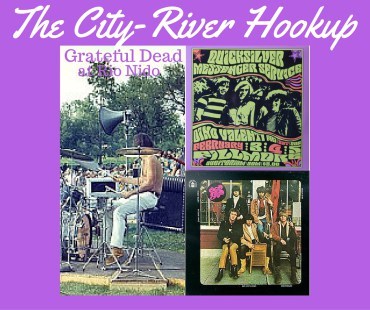 The sixties and seventies epitomized a City/River Rock ‘n’ Roll hookup. Several bands lived within a six-block radius of each other in the Haight Ashbury District of San Francisco during the Summer of Love (1967). In fact, there were over 500 musical groups in the City at the time, many of them playing at the Avalon Ballroom, the Fillmore Auditorium, Winterland, and the Straight Theater. That same year, the Monterey Pop Festival helped to catapulted at least four northern California ensembles to stardom. The Grateful Dead, Big Brother and the Holding Company (with Janis Joplin), Moby Grape and Quicksilver Messenger Service all vaulted to the top of the psychedelic acid heap, soon venturing north to the Russian River to showcase their infusion of Indian, jazz, folk and blues.
The sixties and seventies epitomized a City/River Rock ‘n’ Roll hookup. Several bands lived within a six-block radius of each other in the Haight Ashbury District of San Francisco during the Summer of Love (1967). In fact, there were over 500 musical groups in the City at the time, many of them playing at the Avalon Ballroom, the Fillmore Auditorium, Winterland, and the Straight Theater. That same year, the Monterey Pop Festival helped to catapulted at least four northern California ensembles to stardom. The Grateful Dead, Big Brother and the Holding Company (with Janis Joplin), Moby Grape and Quicksilver Messenger Service all vaulted to the top of the psychedelic acid heap, soon venturing north to the Russian River to showcase their infusion of Indian, jazz, folk and blues.
The Rio Nido Dance Hall and the River Theater in Guerneville were but a few of the venues where these musicians strutted their stuff in Sonoma County.
Rock ‘n’ Roll at the River:
The Grateful Dead’s “Alligator” was supposedly written out on Warnecke Ranch on Chalk Hill Rd in Healdsburg where the boys spent a lot of time. “Dark Star” was born while getting ready to perform at The Barn (Rio Nido Dance Hall) in September of 1967. Their long jams (some lasting 15 minutes) were well suited to “wasted” dancers who had lost track of time. At Guerneville’s River Theater (which was founded in 1947 and showed double feature films), three guitarists of Moby Grape did battle for over two minutes, charging along in “Omaha” from their debut album of 1967 (Moby Grape). Quicksilver Messenger Service showcased many of their songs from Happy Trails (1969) at both The Barn and at the River Theater. Jerry Garcia called it “…the most psychedelic rock album ever recorded”. Other rockers (to name just a few) who have traveled through the San Francisco scene to the River are the Steve Miller Band, Country Joe and the Fish, Elvin Bishop Group, Jefferson Airplane, Paul Butterfield Blues Band, Morning Glory, Overbrook Express, Buffalo Springfield, Jimi Hendrix, and Electric Flag with Occidental’s Nick Gravenites. I say, bring ’em ALL back!
The post The City/River Rock ‘n’ Roll Hookup appeared first on John McCarty.
July 18, 2016
Fleishhacker Pool in San Francisco
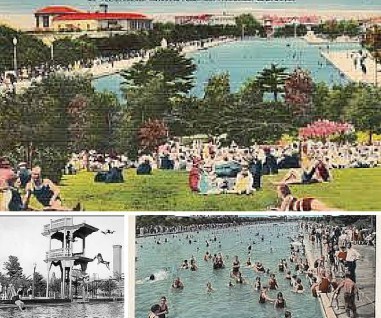 I can remember as a kid swimming at the largest heated saltwater venue in the world, the Fleishhacker Pool in San Francisco. You would take a leap of faith and step off the top platform, a distance of some thirty feet to the water (at that end, it was fifteen feet deep). The pool measured a thousand feet long (over three football fields in length) and a hundred and sixty feet wide in the middle section.
I can remember as a kid swimming at the largest heated saltwater venue in the world, the Fleishhacker Pool in San Francisco. You would take a leap of faith and step off the top platform, a distance of some thirty feet to the water (at that end, it was fifteen feet deep). The pool measured a thousand feet long (over three football fields in length) and a hundred and sixty feet wide in the middle section.
The Parks Commission supposedly kept the temperature of the pool at 72 degrees as required for A.A.U. meets, but it felt much cooler with the damp sea breeze coming off nearby Ocean Beach. In 1925, five thousand spectators watched Johnny Weissmuller, the reigning freestyle champion in the world and later of Tarzan film fame, win his event.
Fleishhacker Pool:
During World War II, the army used Fleishhacker Pool for amphibious assault training. With the return of peacetime, attendance continued to be high. For twenty-five cents (children under twelve during the 1950’s), I received admission, a sterilized bathing suit and a towel. There were some twelve lifeguards on duty as well as a number of patrolling rowboats. Mom would purchase corn dogs and fries at the Fleishhacker Pool’s cafeteria and walk my sisters and I to the man-made, tree-sheltered beach for a picnic. But once again, politicians had other intentions for the desirable land. They surrounded the pool with an ugly cyclone fence as part of a scheme to dissuade the public from using the facility while pursuing ambitions for the construction of residential properties. Some City servants to this day believe that the collapse of the outflow pipe from the pool was the conspiracy of downtown and a small group of contractors. In either case, nothing came of the building projects, but Fleishhacker’s closed forever in 1971. Keep the memories alive. Until next time.
The post Fleishhacker Pool in San Francisco appeared first on John McCarty.
July 10, 2016
Seal Rocks of San Francisco
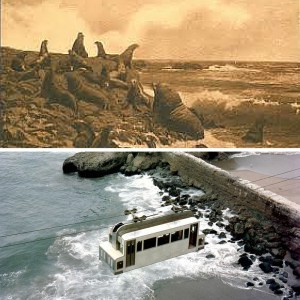
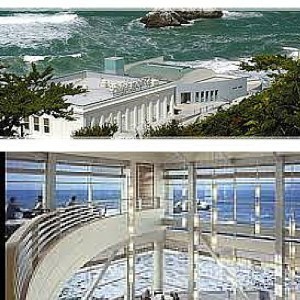 Seal Rocks of San Francisco lies beneath the Cliff House at Lands End in San Francisco. The restaurant has been remodeled in the old neoclassical style with a two-story dining room where you can enjoy the panoramic view of the Pacific Ocean. In recent years patrons would witness only birds on Seal Rocks, but El Nino has driven hordes of the sea lions north looking for food. Sardines, white sea bass, herring and mackerel are luring in the brown fury creatures. Many use Seal Rocks as a resting stop before venturing further up the coast or into the bay to sunbathe near Fisherman’s Wharf and Pier 39.
Seal Rocks of San Francisco lies beneath the Cliff House at Lands End in San Francisco. The restaurant has been remodeled in the old neoclassical style with a two-story dining room where you can enjoy the panoramic view of the Pacific Ocean. In recent years patrons would witness only birds on Seal Rocks, but El Nino has driven hordes of the sea lions north looking for food. Sardines, white sea bass, herring and mackerel are luring in the brown fury creatures. Many use Seal Rocks as a resting stop before venturing further up the coast or into the bay to sunbathe near Fisherman’s Wharf and Pier 39.
Seal Rocks and the Tram:
The seals started appearing in droves in January of 1990 shortly after the Loma Prieta earthquake of ’89. Interesting. I wonder if there was a connection? During the winter, the population of the boisterous critters soon grew to 900. In the summer, they have been migrating south to the Channel Islands to breed. A few, however, remain year round within the Bay, using Seal Rocks and Pier 39 as their permanent homes.
In the old days, a great view of Seal Rocks was had from the Sky Tram, which was first built in 1955 by the Whitney brothers who had been purchasing attractions from The Chutes Amusement Park. For twenty-five cents, you could take the four-minute ride, dangling two hundred feet above the ground. You would embark from just below the Cliff House, travel across the Sutro Baths basin and dismount at Point Lobos promontory where you would be greeted by two man-made waterfalls. But like many good things, the Sky Tram would become the victim of greed. Along with Sutro Baths and Playland At The Beach, the tram closed down to either make room for condos or to become the new playground for unruly youths of the seventies, or so I’ve been told by my unruly friends. Right, Big Steve? Progress comes in many forms, I guess. To each his own.
The post Seal Rocks of San Francisco appeared first on John McCarty.
July 9, 2016
Cliff House of San Francisco
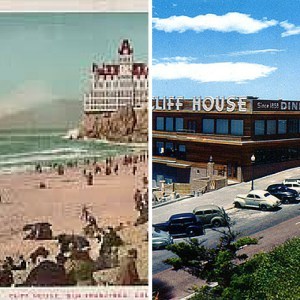 The Cliff House restaurant in San Francisco has been reincarnated five different times on the same site near Lands End. Originally it was built in 1858 from the remains of a ship that crashed on the rocks below. Three Presidents and such local luminaries as Crocker, Hearst and Stanford would drive their carriages through the dunes of the Richmond District to watch the horse races on Ocean Beach and have a bite to eat at the diner. But its reputation spread to the unsavory types from the Barbary Coast region of the City and the area soon became overwhelmed with scandalous behavior.
The Cliff House restaurant in San Francisco has been reincarnated five different times on the same site near Lands End. Originally it was built in 1858 from the remains of a ship that crashed on the rocks below. Three Presidents and such local luminaries as Crocker, Hearst and Stanford would drive their carriages through the dunes of the Richmond District to watch the horse races on Ocean Beach and have a bite to eat at the diner. But its reputation spread to the unsavory types from the Barbary Coast region of the City and the area soon became overwhelmed with scandalous behavior.
Adloph Sutro, entrepreneur and later mayor, had built his estate on Sutro Heights nearby and would have none of the shenanigans. Money can solve any problem, right? He bought the Cliff House and chased out the riffraff. But good karma was not on his side. For the second time, a ship ran aground. This time, however, the schooner was loaded with TNT and exploded, damaging the Cliff House above. The explosion was heard throughout the City. Sutro repaired the restaurant only to see it burn down soon thereafter.
The Cliff House:
The self-made millionaire would not be deterred and rebuilt it in grandiose style, fashioned after a French Chateau, boasting eight stories, four spires, and a two hundred foot observation tower. It survived the 1906 earthquake only to burn down once again the next year. More bad luck was still to come. The President of the U.S. shut down the Cliff House as it was too close to a military base. It remained shuttered during Prohibition as well, but would reopen in the thirties under new ownership. George and Leo Whitney, owners of Playland-at-the-Beach, bought the Cliff House in 1937 and remodeled it. True to their carnival roots, the Whitneys put in a tram to watch the scenery below.
The latest renovation was a joint effort of the present owners, Mary and Dan Hountalas, and the National Park Service. Today the Cliff House is considered the crown jewel of the Golden Gate National Recreation Area. The remodeling restored the building to its neo-classical architecture. The effort also unearthed the old carriage road from 1914, which has been preserved as a walkway around the property. If you venture out for a meal, make reservations for a window seat in the two-story dining room where you can enjoy the panoramic view of the Pacific Ocean and Seal Rocks. By the way, the sea lions are returning. More on the tram and the seals next time. Chow!
The post Cliff House of San Francisco appeared first on John McCarty.
July 4, 2016
Sutro Baths of San Francisco
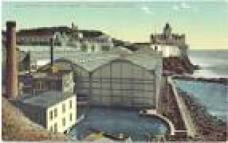 Sutro Baths of San Francisco was built by Adolf Sutro, former mayor (1894-1896), near Lands End and the Cliff House at the western most edge of the Richmond District. In the 1890’s it was hailed as the world’s largest indoor swimming facility with seven pools. During high tide, water would flow directly into the six saltwater pools from the ocean,recycling 2 million gallons in an hour. A powerful turbine pump, which was built inside a cave at sea level, could fill the tanks during low tide at the rate of six thousand gallons per minute.
Sutro Baths of San Francisco was built by Adolf Sutro, former mayor (1894-1896), near Lands End and the Cliff House at the western most edge of the Richmond District. In the 1890’s it was hailed as the world’s largest indoor swimming facility with seven pools. During high tide, water would flow directly into the six saltwater pools from the ocean,recycling 2 million gallons in an hour. A powerful turbine pump, which was built inside a cave at sea level, could fill the tanks during low tide at the rate of six thousand gallons per minute.
Sutro Baths:
In the early fifties I can remember zooming down one of the seven slides. The thirty swinging-ring-trapezes, the many springboards and the high dive offered additional thrills while the whole time being protected from the biting summer fog. The facilities at Sutro Baths also included a 2,700-seat amphitheater, club rooms for 1100, 517 private dressing rooms, a museum and later an ice skating rink. For a small fee, you could rent one of the available 20,000 swim suits and a towel.
Besides the three and half million board feet of lumber, 100,000 sq. ft. of glass and 600 tons of iron were also used in the making of the baths. Everyone thought the structure was invincible. But time would prove them wrong. Due mainly to high maintenance costs, Sutro Baths was closed in 1964. Soon thereafter, an arson fire finished the job for the wrecking ball. The City never did follow up on the proposed high rise apartments for the site, leaving concrete blocks as the only evidence of a once grand dame.
The post Sutro Baths of San Francisco appeared first on John McCarty.
June 30, 2016
The Fun House at S.F.’s Playland
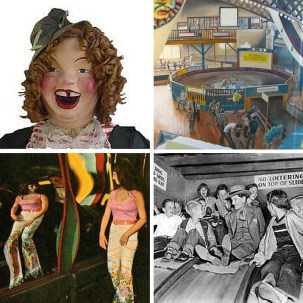 The Fun House at S.F.’s Playland At the Beach was a must for any City kid looking for a laugh, especially since “Laffing Sali” was always obliging. Her demonic cackle greeted you as you entered. You first passed through a maze of mirrors, having a bit of fun at your own expense as twisty or lumpy or skinny figures posed for your entertainment. After squeezing through the spin-dryers, you came across the main area of the Fun House where you might want to take on the Joy Wheel. The challenge was to be the last one sitting on the spinning wooden disc, smirking at all those other kids who had slid off. Nearby was the Barrel of Laughs where most would rush through the rotating wooden structure as fast as possible. Not infrequently there would be a fleshy roadblock as others tumbled over each other, unable to get to their feet and exit.
The Fun House at S.F.’s Playland At the Beach was a must for any City kid looking for a laugh, especially since “Laffing Sali” was always obliging. Her demonic cackle greeted you as you entered. You first passed through a maze of mirrors, having a bit of fun at your own expense as twisty or lumpy or skinny figures posed for your entertainment. After squeezing through the spin-dryers, you came across the main area of the Fun House where you might want to take on the Joy Wheel. The challenge was to be the last one sitting on the spinning wooden disc, smirking at all those other kids who had slid off. Nearby was the Barrel of Laughs where most would rush through the rotating wooden structure as fast as possible. Not infrequently there would be a fleshy roadblock as others tumbled over each other, unable to get to their feet and exit.
Fun House:
If you escaped the barrel unscathed, the Moving Bridges awaited. This was another balancing act as you tried to negotiate connecting gang planks that went up and down. The Fun House also featured rocking horses and staircases as well as air jets (where hopefully your date would do a Marilyn-Monroe-flying-skirt number), rickety catwalks, and so much more. But I think my favorite was the 200′ bumpy slide where you would climb three stories, position a burlap bag under your tush and off you went to race all comers. What was your favorite?
The post The Fun House at S.F.’s Playland appeared first on John McCarty.
June 27, 2016
Playland at the Beach

 The area that was Playland at the Beach in San Francisco was once a squatter’s settlement known as “Moneysville-by-the-Sea”. A steam railroad and a trolley line reached Ocean Beach at the western edge of the Richmond District, delivering you to the Cliff House restaurant, Sutro Baths and a roller coaster (built in 1880’s). By the 1930’s, the Midway had 14 rides, 25 concessions, and 5 diners including Topsy’s Roost.
The area that was Playland at the Beach in San Francisco was once a squatter’s settlement known as “Moneysville-by-the-Sea”. A steam railroad and a trolley line reached Ocean Beach at the western edge of the Richmond District, delivering you to the Cliff House restaurant, Sutro Baths and a roller coaster (built in 1880’s). By the 1930’s, the Midway had 14 rides, 25 concessions, and 5 diners including Topsy’s Roost.
I can remember my folks taking me on the mini-dipper (also known as The Bob’s), the carousel, the Ferris wheel, Noah’s Ark, the Aeroplane Swing and the Whip, which was a 2-seater car that ran on a track. When you sped around a turn, the car would whip to one side, sliding you across your seat. If you dared to ride the Big Dipper, you had to hold both hands above your head as you dropped eighty feet, the sound of whooshing wheels chasing after you. I read once that a man was thrown from the ride and killed back in the fifties.
Playland:
If you wanted to cool off on a scorching day at Playland, you could ride Shoot-the-chutes. You’d board a flat bottom boat and sail down a steep, watery ramp. A humongous splash was waiting for you in the lagoon. Do you remember the Skyliner where you could float across the entire area from a cable above? Another favorite of mine was the Diving Bell where you would enter a metal chamber, which took you underwater before returning you to the surface with a resounding thud. Only after I was completely exhausted would I be treated to a Bull Pup enchilada. I can still taste that one-of-a-kind sauce. To top off the day, an It’s It ice cream sandwich waited for me (Sidebar: It’s It started at Playland). My parents would ignore my cries to go to the Fun House, promising to take me there another day. Laughing Sal awaits us. Until then, my City friends, take care.
The post Playland at the Beach appeared first on John McCarty.
June 23, 2016
Stumptown Daze Parade
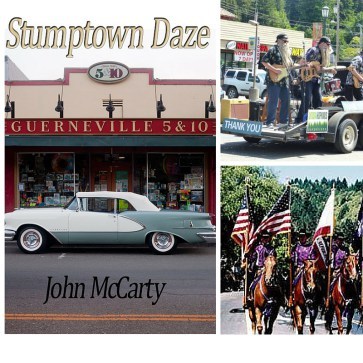 The Stumptown Daze parade this last Saturday in Guerneville was a hoot. I never get tired of this small town tradition. All that was the lower Russian River was represented. You had mounted honor guard, rodeo queens, antique fire trucks, politicians, the El Molino H.S. Marching Band, erotic clowns, classic cars and so much more. One of my personal favorites was a gray-haired musical group that belted out some nifty dixie and jazz tunes. Never too old to swing. There was also a ragtag group of folks who live on the edge out here along the River. They festooned themselves with a mishmash of colorful hats, striped capes, and wide grins. As my grandfather once said, “If you’re not living on the edge, you’re taking up too much room.” Everyone was welcomed to participate and why not.
The Stumptown Daze parade this last Saturday in Guerneville was a hoot. I never get tired of this small town tradition. All that was the lower Russian River was represented. You had mounted honor guard, rodeo queens, antique fire trucks, politicians, the El Molino H.S. Marching Band, erotic clowns, classic cars and so much more. One of my personal favorites was a gray-haired musical group that belted out some nifty dixie and jazz tunes. Never too old to swing. There was also a ragtag group of folks who live on the edge out here along the River. They festooned themselves with a mishmash of colorful hats, striped capes, and wide grins. As my grandfather once said, “If you’re not living on the edge, you’re taking up too much room.” Everyone was welcomed to participate and why not.
Stumptown Daze:
Others in the parade greeted kiddies with a friendly handshake and free candies. A lady aboard a black stallion and wearing a lavish Arabian dress, stopped to take pics with the locals. All of this was trailed by a resident pooper-scooper who wanted nothing more to complete her day than the opportunity to gather up manure for the benefit of the town. The laughter and spirit of the community is contagious. This is not just some catchy phrase but you honestly feel engulfed in this sea of pride. The Stumptown Daze parade brings the “belonging” out of you. You are one of the crowd. You are a member of a small and tight group of locals.
This sense of community inspired me to write Stumptown Daze, a historical fiction novel where a bunch of characters all come together in the 1960’s. All of the local newspapers have given it rave reviews. But you judge for yourself. Who knows, it might just bring back to life some of those old memories of the River that you buried so many moons ago. Cheers! http://www.johnmccarty.org/
The post Stumptown Daze Parade appeared first on John McCarty.
June 13, 2016
Bohemian Grove in Monte Rio
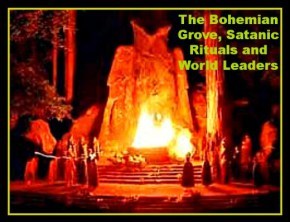
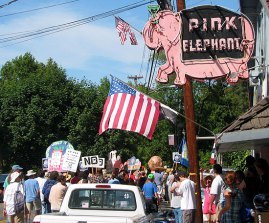 In recent years the most powerful men in America have attended the July retreat at the Bohemian Grove in Monte Rio along the lower reaches of the Russian River. Government types with names like Bush & Powell & Kissinger & Rumsfeld rub elbows with the Lee Iacoccas & Bill Gates of this world. With its combination of power and wealth, the Bohemian Grove has long been the target of several protests, some highly charged.
In recent years the most powerful men in America have attended the July retreat at the Bohemian Grove in Monte Rio along the lower reaches of the Russian River. Government types with names like Bush & Powell & Kissinger & Rumsfeld rub elbows with the Lee Iacoccas & Bill Gates of this world. With its combination of power and wealth, the Bohemian Grove has long been the target of several protests, some highly charged.
Bohemian Grove:
Mary Moore, a former beauty queen turned left-wing activist, has spearheaded the Bohemian Grove Action Network of Occidental, California. She held her own “Resurrection of Care” ceremony to impress upon the political officials that they SHOULD care about the infiltration of corporations into the American government. The B.G.A.N. has also aided journalists who wished to penetrate the secret surroundings of the Grove. Phillip Weiss of Spy magazine once said: “You know you are inside the Bohemian Grove when you come down a trail in the woods and hear piano music from amid a group of tents and then round a bend to see a man with a beer in one hand and his penis in the other…” Ron Jenson in a five-part Channel 4 documentary, Secret Rulers of the World, said that there was an overwhelming presence of Elvis impersonators, pseudo-pagan spooky rituals, and heavy drinking. In 2002, 37-year-old Richard McCaslin had heard on a Texas radio station that officials were burning children upon an altar at the Bohemian Grove in northern California. He came heavily armed, wearing a skull mask and outfitted with “Phantom Patriot” written across his chest. After setting several fires and squaring off against the local Sheriff’s department, he surrendered and was arrested. Boys will be boys.
The post Bohemian Grove in Monte Rio appeared first on John McCarty.

